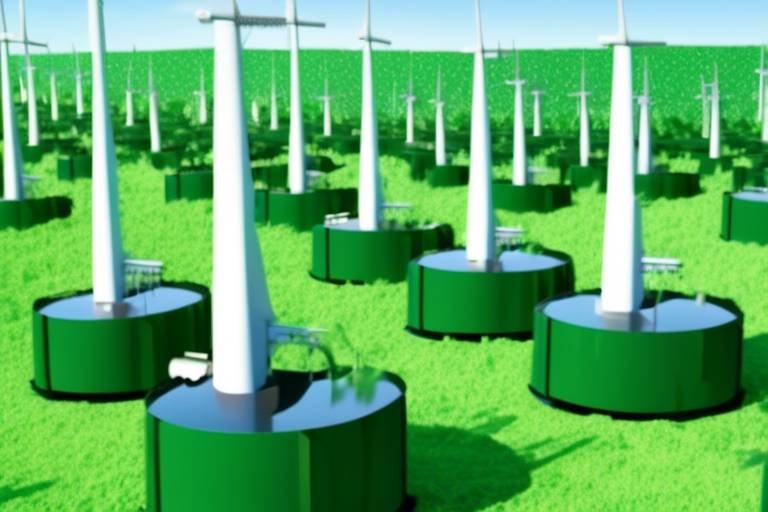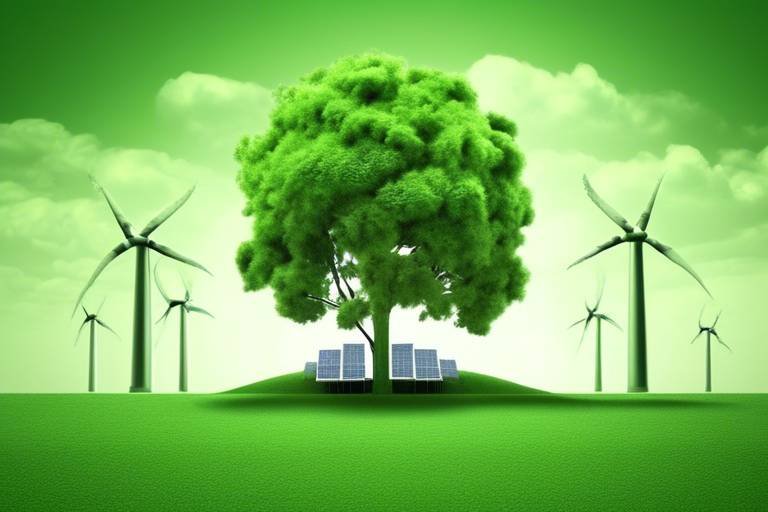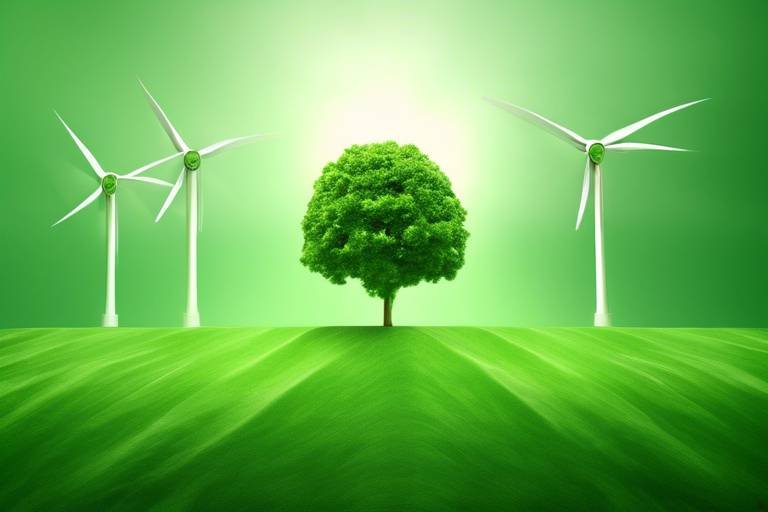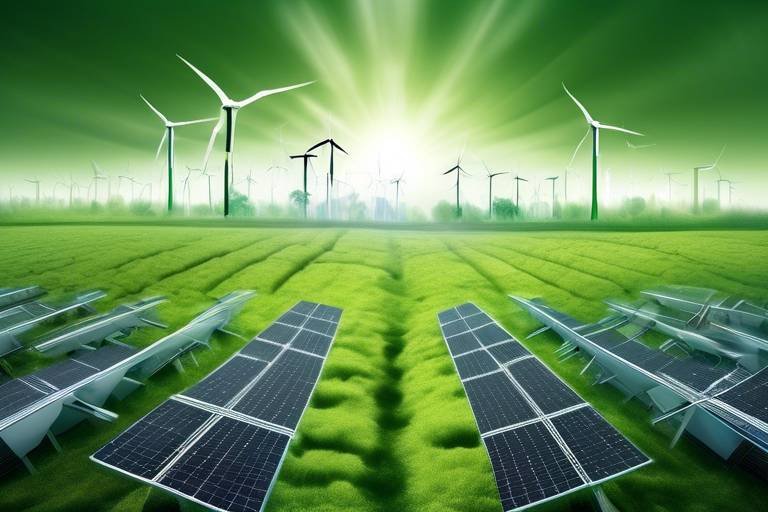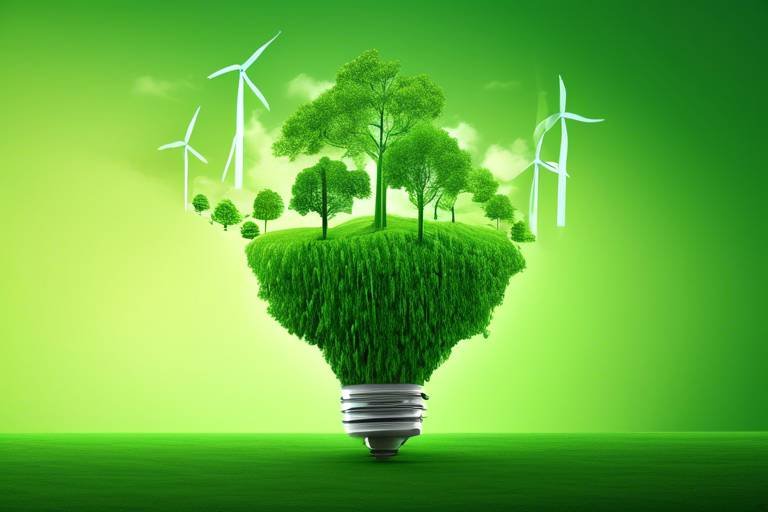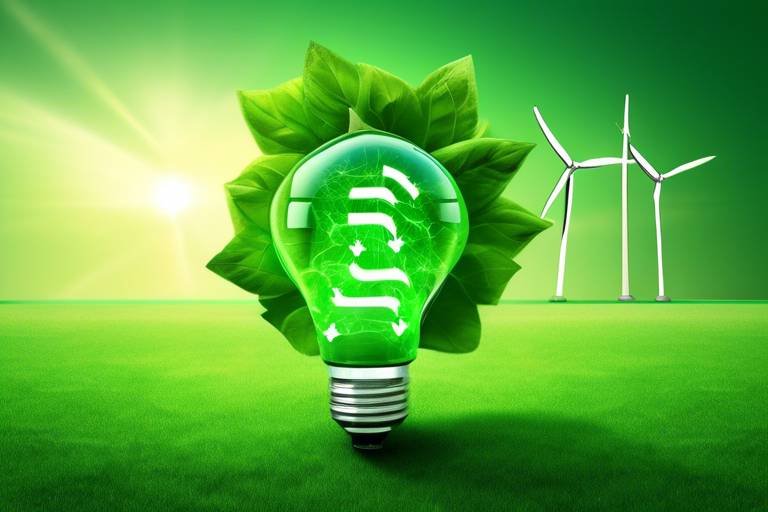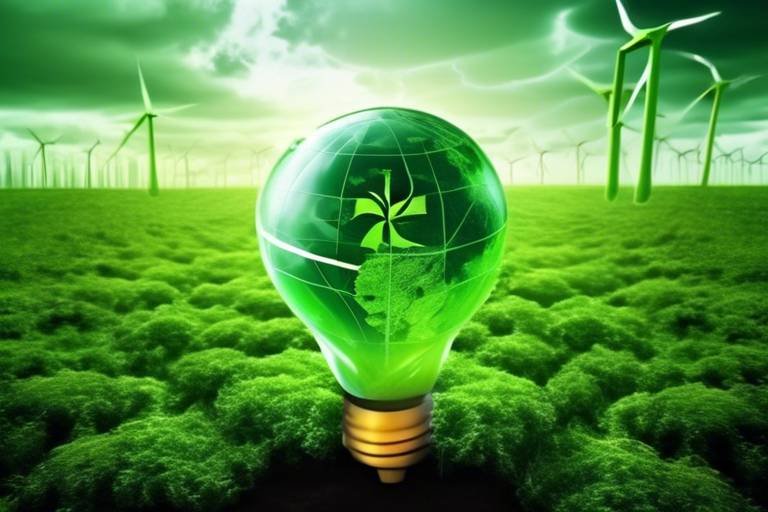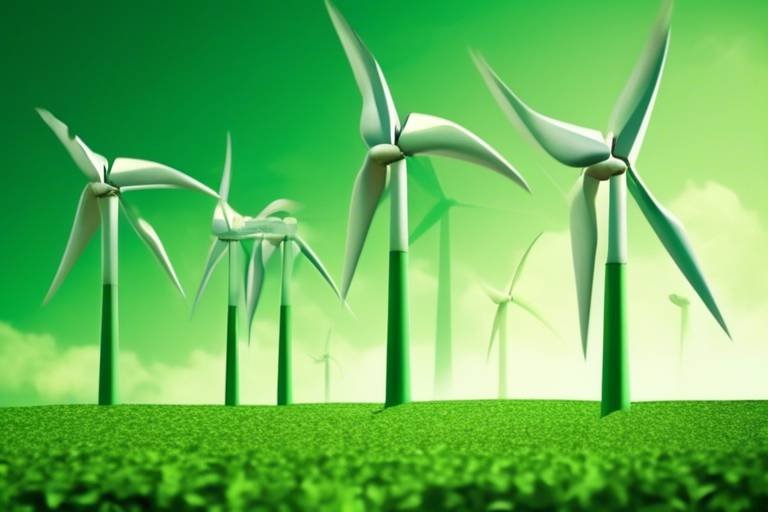The Environmental Cost of Green Energy Equipment – A Thorough Analysis
In recent years, the world has shifted its focus towards sustainable energy solutions, driven by the urgent need to combat climate change and reduce our reliance on fossil fuels. However, while green energy equipment like solar panels, wind turbines, and batteries are often hailed as the heroes of this transition, it's crucial to peel back the layers and examine the hidden environmental costs associated with their production, usage, and disposal. This article aims to shed light on these complexities, revealing that the path to sustainability is not as straightforward as it may seem.
Green energy equipment encompasses a variety of technologies designed to harness renewable resources. Solar panels convert sunlight into electricity, wind turbines capture wind energy, and batteries store this energy for later use. Each of these technologies plays a pivotal role in our transition towards sustainable energy sources, promising a cleaner, greener future. But, have you ever stopped to think about what goes into making these devices? The truth is, the production of this equipment is not without its environmental impacts, which we will explore in detail.
The manufacturing of green energy equipment involves intricate processes that often require substantial energy and raw materials. From the extraction of minerals to the assembly of high-tech components, the environmental footprint of these processes can be significant. For instance, the production of solar panels requires silicon, which is derived from quartz, and the extraction and refinement of these materials can lead to habitat destruction and pollution. Furthermore, the energy consumed during manufacturing can contribute to greenhouse gas emissions, raising questions about the overall sustainability of these technologies.
One of the most pressing concerns regarding green energy equipment is the ecological consequences of mining for raw materials. Essential components like lithium, cobalt, and rare earth elements are critical for batteries and other technologies. The demand for these materials has led to extensive mining operations, often in ecologically sensitive areas. The environmental degradation caused by these activities can be profound, leading to soil erosion, water contamination, and loss of biodiversity. In many cases, local communities bear the brunt of these impacts, raising ethical concerns about the sustainability of our green energy solutions.
Another often-overlooked aspect of green energy equipment production is the significant amount of water required. For example, the manufacturing of solar panels not only consumes water during the production process but also during the extraction of raw materials. This can strain local water resources, especially in arid regions, affecting agricultural activities and drinking water supplies. The balance between harnessing renewable energy and conserving precious water resources is a tightrope that must be carefully navigated.
As we delve deeper, the carbon emissions generated during the manufacturing phase of green energy equipment cannot be ignored. While these technologies are designed to reduce carbon footprints during their operational life, the initial manufacturing process can be carbon-intensive. For instance, the production of wind turbines involves steel and concrete, both of which have substantial carbon footprints. Thus, while transitioning to green energy is essential, we must also consider the complete lifecycle of these technologies to truly measure their sustainability.
To better understand the environmental impacts of green energy equipment, life cycle assessments (LCAs) provide a comprehensive overview. LCAs evaluate the environmental effects of a product from cradle to grave, encompassing everything from raw material extraction to manufacturing, usage, and disposal. By utilizing LCAs, stakeholders can identify the stages of production that contribute most significantly to environmental degradation and target improvements accordingly. This holistic approach is vital for developing more sustainable practices in the green energy sector.
As we embrace green energy technologies, we must also confront the challenges associated with their end-of-life management. Solar panels and batteries have finite lifespans, and their disposal poses significant environmental risks. Improper disposal can lead to hazardous materials leaching into the soil and water systems, causing long-term ecological damage. Moreover, the recycling infrastructure for these technologies is still in its infancy, making it imperative to develop effective strategies for managing waste and promoting circular economy practices.
Fortunately, advancements in recycling technologies are emerging to mitigate the environmental footprint of discarded green energy equipment. Innovative processes are being developed to recover valuable materials from old solar panels and batteries, reducing the need for new resource extraction. These technologies not only help in minimizing waste but also contribute to the sustainability of the overall energy system. However, widespread adoption and investment in these technologies are essential for realizing their full potential.
The role of government policies and regulations is crucial in managing the environmental costs associated with green energy equipment. Effective policies can promote sustainable practices, encourage recycling, and ensure that manufacturers adhere to environmental standards. By fostering an environment that prioritizes sustainability, governments can help drive innovation and accountability within the green energy sector, ultimately leading to more responsible consumption and production practices.
Looking ahead, it is clear that the journey towards a truly sustainable energy future requires a multi-faceted approach. Strategies such as improving manufacturing processes, enhancing recycling technologies, and implementing robust regulations are essential. Additionally, fostering public awareness and education about the environmental costs of green energy equipment can empower consumers to make informed choices. By addressing these challenges head-on, we can ensure that the transition to renewable energy is not only effective but also genuinely sustainable.
- What are the main environmental impacts of green energy equipment? The main impacts include resource extraction, water usage, carbon emissions during manufacturing, and end-of-life disposal challenges.
- How can we improve the sustainability of green energy technologies? By enhancing recycling technologies, improving manufacturing processes, and implementing effective government policies.
- What role do life cycle assessments play in evaluating green energy equipment? LCAs provide a comprehensive view of the environmental impacts throughout the entire lifecycle of the equipment.
- Why is recycling important for green energy equipment? Recycling helps recover valuable materials, reduces waste, and minimizes the need for new resource extraction, contributing to a more sustainable energy system.

Understanding Green Energy Equipment
When we talk about green energy equipment, we're diving into a fascinating world that encompasses various technologies designed to harness renewable energy sources. This includes solar panels, wind turbines, and batteries, each playing a critical role in our journey towards a more sustainable future. Imagine a world where energy is clean, abundant, and accessible to all—this is the vision that green energy equipment helps us realize.
Solar panels, for instance, are the shining stars of renewable energy. They capture sunlight and convert it into electricity, providing a sustainable power source that reduces our reliance on fossil fuels. But it's not just about the panels themselves; it's also about how they are produced and installed. The manufacturing process can have significant environmental impacts, which we will explore in further sections.
Then there are wind turbines, which harness the power of the wind to generate electricity. These towering structures are often seen dotting the landscape, turning wind into energy. However, have you ever considered the materials that go into making these turbines? The production of wind turbines requires various raw materials, including metals and rare earth elements, which come with their own environmental costs.
Lastly, we can't forget about batteries, especially with the rise of electric vehicles and energy storage systems. Batteries are essential for storing the energy generated by solar and wind sources, allowing us to use this energy even when the sun isn’t shining or the wind isn’t blowing. However, the production and disposal of batteries, particularly those that use lithium and cobalt, can lead to serious environmental challenges.
To better understand the impact of green energy equipment, it's crucial to consider the entire ecosystem surrounding these technologies. Not only do they provide cleaner energy options, but they also influence economic growth, job creation, and energy independence. However, the journey toward sustainability is complex, and while green energy equipment is a step in the right direction, it is not without its own set of challenges.
In summary, green energy equipment is a vital component of our transition to sustainable energy sources. Each piece of equipment plays a role in this ecosystem, but we must also acknowledge the environmental costs associated with their production, use, and disposal. As we continue to innovate and improve these technologies, the hope is that we can find ways to minimize their environmental footprints while maximizing their benefits.

Manufacturing Processes and Their Impacts
The journey of green energy equipment begins long before it reaches your rooftop or powers your electric vehicle. Understanding the manufacturing processes involved in creating solar panels, wind turbines, and batteries reveals a complex web of environmental impacts that many consumers are unaware of. While these technologies are lauded for their potential to reduce carbon emissions and combat climate change, the path to their production is often paved with significant ecological costs.
At the heart of manufacturing green energy equipment lies the extraction of raw materials. This phase is crucial, as it involves mining for resources such as silicon for solar panels, lithium for batteries, and various metals for wind turbines. The energy consumption required for these processes is staggering, often relying on fossil fuels that contribute to greenhouse gas emissions. For instance, the production of a single solar panel can require up to 200 liters of water, along with copious amounts of energy, raising questions about the sustainability of such practices.
When we talk about resource extraction, we must consider its ecological consequences. The mining of critical materials like lithium, cobalt, and rare earth elements often leads to deforestation, soil degradation, and water pollution. For example, lithium extraction in South America has raised alarms due to its impact on local water resources, affecting both human populations and wildlife. The irony is palpable: in our quest for a greener future, we may inadvertently be causing harm to the very ecosystems we aim to protect.
Water is a vital component in the manufacturing of green energy technologies. The production of solar panels, for instance, involves extensive cleaning processes that consume significant amounts of water. This usage can strain local water supplies, especially in arid regions where water scarcity is already a pressing issue. As we push for more renewable energy solutions, it's essential to evaluate the water footprint of these technologies and consider how we can mitigate their impact on local communities and ecosystems.
Another critical aspect to consider is the carbon footprint associated with the manufacturing phase. The energy-intensive processes involved in producing green energy equipment can generate substantial carbon emissions. For example, studies have shown that the carbon emissions from manufacturing a typical wind turbine can be equivalent to the emissions produced by driving a car for several years. This paradox highlights the importance of assessing the overall sustainability of renewable technologies, as we must not only focus on their operational benefits but also their manufacturing impacts.
To gain a comprehensive understanding of the environmental costs, life cycle assessments (LCAs) are employed. These evaluations consider the entire lifespan of green energy equipment—from raw material extraction to production, usage, and eventual disposal. By analyzing these stages, we can identify the most significant environmental impacts and work towards minimizing them. For instance, an LCA might reveal that while solar panels produce clean energy during their operational phase, their production and end-of-life disposal pose considerable challenges that need to be addressed.
In conclusion, while green energy equipment represents a promising step towards a sustainable future, it's crucial to recognize the hidden environmental costs associated with their manufacturing. As consumers and advocates for renewable energy, we must push for greater transparency and innovations that reduce the ecological footprint of these technologies. By doing so, we can ensure that our transition to green energy is genuinely sustainable and beneficial for the planet.
- What are the key materials used in green energy equipment? The primary materials include silicon for solar panels, lithium for batteries, and various metals for wind turbines.
- How does the manufacturing process impact the environment? Manufacturing processes can lead to significant energy consumption, resource extraction, and carbon emissions, affecting local ecosystems.
- What is a life cycle assessment (LCA)? An LCA evaluates the environmental impacts of a product throughout its entire life span, from production to disposal.
- Are there innovations in recycling green energy equipment? Yes, advancements in recycling technologies are being developed to minimize the environmental footprint of discarded equipment.

Resource Extraction and Sustainability
The journey towards a greener future often comes with a paradox: while green energy equipment like solar panels and wind turbines is designed to reduce our carbon footprint, the resource extraction needed to manufacture these technologies can have significant ecological consequences. The raw materials required for the production of green energy systems, such as lithium for batteries, cobalt for electric vehicle components, and rare earth elements for wind turbines, are not just abundant and easy to obtain. In fact, their extraction can lead to severe environmental degradation.
Mining operations, particularly in developing nations, can result in deforestation, habitat destruction, and pollution of local water sources. For instance, lithium mining, which is crucial for battery production, often involves the extraction of brine from salt flats. This process can consume vast amounts of water, which is particularly concerning in arid regions where water is already scarce. The ecological footprint of these mining activities raises a critical question: are we truly achieving sustainability if the means of producing green energy equipment harms the environment?
Moreover, the extraction of cobalt, primarily sourced from the Democratic Republic of the Congo, has been linked to human rights abuses and unsafe working conditions. This not only poses ethical dilemmas but also highlights the complex web of sustainability that we must navigate. We cannot ignore the fact that the pursuit of green technology must also take into account the social and environmental costs associated with sourcing the materials that make these technologies possible.
To better understand the impacts of resource extraction, let’s consider a few key aspects:
- Environmental Degradation: Mining operations can lead to soil erosion, water contamination, and loss of biodiversity.
- Water Scarcity: The extraction processes often require significant water resources, exacerbating local water shortages.
- Human Rights Violations: Many mining practices, especially in developing countries, can involve exploitation and unsafe labor practices.
In light of these challenges, it is essential to adopt a more sustainable approach to resource extraction. This could involve implementing stricter regulations, promoting responsible mining practices, and investing in recycling technologies that reduce the need for virgin materials. By focusing on sustainable sourcing and enhancing the efficiency of material use, we can mitigate some of the negative impacts associated with the production of green energy equipment.
Ultimately, the path to a sustainable energy future requires a holistic view of the entire lifecycle of green energy technologies. It’s not just about generating clean energy; it’s about ensuring that every step of the process—from extraction to disposal—is managed in a way that protects our planet and its people.
- What are the main materials used in green energy equipment?
Common materials include lithium, cobalt, copper, and rare earth elements. - How does mining affect local communities?
Mining can lead to displacement, pollution, and health issues for local populations. - Are there alternatives to traditional mining?
Yes, recycling existing materials and developing synthetic alternatives can reduce the need for new resource extraction.

Water Usage in Production
When we think about green energy, we often envision clean, sustainable solutions that help combat climate change. However, a crucial aspect that often gets overlooked is the significant water usage involved in the production of green energy equipment. From solar panels to wind turbines, the manufacturing processes require a substantial amount of water, which can have profound effects on local ecosystems and communities.
For instance, the production of solar panels involves several stages, including the purification of silicon, which is a water-intensive process. It’s estimated that producing just one ton of silicon can consume up to 2,000 liters of water. This is not just a trivial concern; in regions where water is already scarce, such high consumption can lead to competition for resources among industrial, agricultural, and residential users. As a result, local communities may face water shortages, affecting their daily lives and agricultural activities.
Moreover, the water used in manufacturing is often not returned to the environment in the same condition. Many industrial processes discharge wastewater that can be laden with harmful chemicals, which can further degrade local water quality. For example, the use of certain solvents and acids in the cleaning and etching of solar cells can lead to toxic runoff, posing risks to aquatic life and human health.
To put this into perspective, consider the following table that outlines the water consumption of various green energy technologies:
| Technology | Water Usage (liters per unit) |
|---|---|
| Solar Panels | 2,000 |
| Wind Turbines | 1,500 |
| Batteries (Lithium-ion) | 1,200 |
As we can see, the water footprint varies across different technologies, but it’s evident that the production of green energy equipment is not as water-neutral as one might assume. This leads us to a critical question: how can we balance the need for renewable energy with the pressing need to conserve water? One potential solution lies in improving manufacturing processes to minimize water usage and enhance recycling efforts to reclaim water used in production.
In conclusion, while green energy technologies are essential for a sustainable future, we must not ignore the environmental costs associated with their production, particularly regarding water usage. By addressing these challenges head-on, we can work towards a more sustainable approach to renewable energy that truly benefits both the planet and its inhabitants.

Carbon Footprint of Manufacturing
The manufacturing of green energy equipment, while aimed at reducing overall carbon emissions, paradoxically contributes significantly to the carbon footprint itself. This is a complex issue that often gets overlooked in the broader narrative of sustainability. To put it simply, the production processes for items like solar panels, wind turbines, and batteries require substantial amounts of energy, much of which is still derived from fossil fuels. For instance, the production of solar panels involves not just the energy used in their assembly, but also the energy consumed in the extraction and processing of raw materials such as silicon, silver, and various chemicals.
Moreover, the carbon emissions associated with these manufacturing processes can vary widely depending on the location and the energy sources used. In regions where coal is the primary energy source, the carbon footprint can be considerably higher than in areas that utilize renewable energy for production. This brings us to a crucial point: while green technologies are designed to deliver clean energy, the initial stages of their life cycle can be anything but green. A recent study indicated that the carbon footprint of manufacturing solar panels can range from 30 to 70 grams of CO2 per kilowatt-hour (gCO2/kWh) produced, depending on the methods and materials involved.
To illustrate this further, consider the following table that summarizes the carbon emissions associated with different green energy equipment manufacturing processes:
| Equipment Type | Carbon Emissions (gCO2/kWh) | Primary Energy Source |
|---|---|---|
| Solar Panels | 30 - 70 | Coal, Natural Gas, Renewables |
| Wind Turbines | 10 - 30 | Coal, Natural Gas, Renewables |
| Batteries (Lithium-ion) | 150 - 200 | Coal, Natural Gas |
This table highlights that while wind turbines generally have a lower carbon footprint compared to solar panels, the production of lithium-ion batteries is notably more carbon-intensive. This is largely due to the energy-intensive processes required to extract and refine lithium and cobalt, essential components of these batteries. As we continue to push for a greener future, it's essential to recognize that the journey begins with understanding and mitigating these initial carbon emissions.
Ultimately, addressing the carbon footprint of manufacturing green energy equipment requires a multi-faceted approach. This includes investing in cleaner production technologies, utilizing renewable energy sources for manufacturing, and enhancing the efficiency of resource extraction processes. By tackling these challenges head-on, we can make significant strides toward achieving true sustainability in the green energy sector.
- What is the carbon footprint of solar panels? The carbon footprint of solar panels can range from 30 to 70 grams of CO2 per kilowatt-hour produced, depending on the manufacturing process and energy sources used.
- How does the production of wind turbines compare to solar panels? Wind turbines generally have a lower carbon footprint, ranging from 10 to 30 grams of CO2 per kilowatt-hour, compared to solar panels.
- What are the main contributors to the carbon footprint of batteries? The extraction and refining of lithium and cobalt are significant contributors to the carbon emissions associated with lithium-ion battery production.
- How can we reduce the carbon footprint of green energy equipment? By investing in cleaner production technologies, using renewable energy sources for manufacturing, and improving resource extraction efficiency, we can reduce the carbon footprint significantly.

Life Cycle Assessment of Green Energy Equipment
When we talk about green energy equipment, it’s essential to consider its entire journey—from the moment raw materials are extracted to when the equipment is finally disposed of. This is where Life Cycle Assessment (LCA) comes into play. An LCA provides a comprehensive overview of the environmental impacts associated with each stage of a product's life. It’s like looking at a movie from start to finish, allowing us to understand not just the plot twists but also the underlying themes that shape the narrative.
In the case of green energy technologies, LCAs typically focus on several key phases:
- Raw Material Extraction: This phase often involves significant ecological disruption. For instance, mining for lithium and cobalt can lead to habitat destruction and pollution.
- Manufacturing: The energy-intensive processes required to produce solar panels, wind turbines, and batteries contribute to greenhouse gas emissions, raising questions about the sustainability of these technologies.
- Transportation: The logistics of moving these heavy materials and equipment can also contribute to their carbon footprint, adding another layer to the environmental impact.
- Usage: While in operation, green energy equipment generally has a positive environmental impact, reducing reliance on fossil fuels and lowering emissions.
- End-of-Life: This phase is often overlooked, yet it poses significant challenges. Improper disposal can lead to toxic materials leaching into the environment.
By evaluating each of these stages, we can identify the critical areas where improvements can be made. For example, if we focus on reducing emissions during the manufacturing phase, we can significantly enhance the overall sustainability of green energy technologies.
Moreover, LCAs often involve complex calculations and assumptions, which can lead to varying results. This variability can create confusion among consumers and policymakers alike. It’s crucial, then, to standardize LCA methodologies to ensure that we are making informed decisions based on reliable data. By doing so, we can better understand the true environmental cost of green energy equipment and work towards reducing it.
In conclusion, while green energy technologies are vital for a sustainable future, we must approach them with a critical eye. Life Cycle Assessments provide a roadmap for understanding their environmental impacts and highlight the need for continuous improvement. By focusing on the entire life cycle, we can make strides towards truly sustainable energy solutions that not only reduce emissions but also minimize ecological harm.
- What is a Life Cycle Assessment (LCA)? An LCA evaluates the environmental impacts of a product throughout its entire life cycle, from raw material extraction to disposal.
- Why is LCA important for green energy equipment? It helps identify the environmental impacts associated with each stage of the product's life, allowing for informed decision-making and improvements.
- What are the main stages of an LCA? The main stages include raw material extraction, manufacturing, transportation, usage, and end-of-life disposal.
- How can LCAs improve sustainability? By pinpointing areas of high environmental impact, LCAs guide manufacturers and policymakers toward more sustainable practices.

End-of-Life Challenges
The journey of green energy equipment doesn't end once it has served its purpose; in fact, that's where a whole new set of challenges begins. As we embrace solar panels, wind turbines, and batteries in our quest for sustainable energy, we must also confront the reality of what happens when these technologies reach the end of their lifespan. It's not just about generating clean energy; it's about ensuring that the materials used in these devices do not become a burden on our environment once they are discarded. The disposal and recycling of green energy equipment present significant hurdles that need to be addressed to truly achieve sustainability.
For instance, take solar panels. Many people might assume that once they’re no longer functional, they can simply be tossed into the recycling bin. However, the reality is far more complex. A typical solar panel contains a mix of materials, including glass, silicon, and various metals, some of which can be hazardous. When these panels are improperly disposed of, they can leach toxic substances into the environment, causing soil and water contamination. This highlights the urgent need for effective recycling processes that can safely reclaim valuable materials while minimizing environmental harm.
Similarly, batteries, particularly lithium-ion batteries used in electric vehicles and renewable energy storage, pose their own set of end-of-life challenges. As the demand for these batteries increases, so too does the concern about their disposal. The chemicals within batteries can be harmful if not managed correctly. Moreover, the recycling rate for lithium-ion batteries is currently low, which means that a significant number of them end up in landfills. This not only wastes valuable resources but also poses a risk of fires and chemical leaks.
To illustrate the scale of this problem, consider the following table that outlines the estimated lifespans and recycling challenges for various types of green energy equipment:
| Type of Equipment | Typical Lifespan (Years) | Recycling Rate (%) | End-of-Life Challenges |
|---|---|---|---|
| Solar Panels | 25-30 | 10-15 | Toxic materials, leaching, landfill waste |
| Wind Turbines | 20-25 | Less than 5 | Composite materials, disposal issues |
| Lithium-ion Batteries | 5-15 | Less than 5 | Chemical hazards, low recycling rates |
As you can see, the recycling rates are alarmingly low, especially when considering the potential for reclaiming valuable materials. Moreover, the challenges are not just technical; they also involve regulatory and economic factors. Governments and industries must collaborate to develop effective policies and incentives that promote recycling and responsible disposal practices. This can include establishing take-back programs, improving recycling technologies, and investing in research to find more sustainable materials that can be easily recycled.
In conclusion, while green energy technologies are crucial for reducing our carbon footprint, we cannot overlook the end-of-life challenges they present. It’s a classic case of needing to think ahead: just as we are transitioning to cleaner energy sources, we must also develop a comprehensive strategy for managing the waste generated by these technologies. Only then can we truly claim to be moving towards a sustainable future.
- What happens to solar panels when they reach the end of their life? Solar panels can be recycled, but many end up in landfills, which can lead to environmental contamination.
- Are lithium-ion batteries recyclable? Yes, but the recycling rate is currently low, and improper disposal can be hazardous.
- What are the main materials used in green energy equipment? Common materials include silicon, metals like aluminum and copper, and various polymers.
- How can I ensure proper disposal of green energy equipment? Look for local recycling programs or take-back initiatives that specialize in electronic waste.

Recycling Technologies and Innovations
As the world shifts towards greener energy solutions, the importance of recycling technologies and innovations cannot be overstated. With the rapid deployment of green energy equipment, such as solar panels and wind turbines, we face a growing challenge: how do we manage the waste generated by these technologies once they reach the end of their life cycle? Fortunately, innovative recycling methods are emerging, aiming to minimize the environmental footprint of discarded green energy equipment.
One of the most promising advancements in recycling technologies is the development of closed-loop recycling systems. These systems are designed to recover valuable materials from old solar panels and batteries, allowing them to be reused in new products. For instance, companies are now able to extract metals like silver, aluminum, and copper from solar panels, which significantly reduces the need for new raw materials. This not only conserves natural resources but also cuts down on the energy consumption associated with mining and processing.
Another exciting innovation is the use of hydrometallurgical processes for battery recycling. This method involves dissolving battery components in a liquid solution, enabling the recovery of critical materials like lithium, cobalt, and nickel. By efficiently reclaiming these materials, we can reduce the environmental damage caused by traditional mining practices. Moreover, these processes can operate at lower temperatures, which further decreases their carbon footprint.
But it's not just about recovering materials; it's also about improving the overall efficiency of recycling operations. Advanced robotics and artificial intelligence are being integrated into recycling facilities to enhance sorting and processing capabilities. These technologies can identify and separate recyclable materials more accurately and quickly than humans, leading to higher recovery rates and less contamination in the recycling stream.
To illustrate the impact of these innovations, consider the following table that summarizes key recycling technologies and their benefits:
| Recycling Technology | Key Benefits |
|---|---|
| Closed-loop recycling systems | Reduces need for new raw materials; conserves energy |
| Hydrometallurgical processes | Efficient recovery of critical battery materials; lower environmental impact |
| AI and robotics in recycling | Improved sorting accuracy; higher recovery rates |
However, despite these advancements, challenges remain. The current recycling infrastructure is often inadequate to handle the increasing volume of green energy equipment waste. Many regions still lack the facilities capable of processing these materials effectively. Therefore, it is crucial for governments and private sectors to invest in expanding recycling capabilities and developing standardized protocols for recycling green energy equipment.
In conclusion, while the environmental costs associated with green energy equipment are significant, the innovations in recycling technologies provide a glimmer of hope. By leveraging these advancements, we can work towards a more sustainable future where green energy solutions do not come at the expense of our planet. As we continue to innovate and improve our recycling efforts, we can ensure that the transition to renewable energy is as green as it claims to be.
- What materials can be recycled from solar panels? Solar panels can be recycled to recover metals like silver, aluminum, and copper.
- How do hydrometallurgical processes work? These processes dissolve battery components in a liquid solution to recover critical materials.
- What role does AI play in recycling? AI improves sorting accuracy and increases recovery rates in recycling facilities.
- Are there enough recycling facilities for green energy equipment? Currently, many regions lack adequate facilities to manage the growing volume of waste from green energy technologies.

Policy and Regulation Implications
The transition to green energy is not just a technological shift; it also requires a robust framework of policies and regulations to ensure that the environmental costs associated with green energy equipment are managed effectively. Governments around the world are recognizing the need for comprehensive policies that not only promote the adoption of renewable energy technologies but also address the potential negative impacts of their production and disposal.
One of the key areas where policy plays a crucial role is in resource management. For instance, regulations surrounding the mining of materials like lithium and cobalt are essential to mitigate the ecological damage caused by extraction processes. Effective policies can enforce sustainable mining practices, ensuring that companies are held accountable for their environmental footprint. This could involve requiring companies to conduct Environmental Impact Assessments (EIAs) before beginning extraction activities, thus promoting a balance between energy production and ecological preservation.
Furthermore, as we look towards the end-of-life phase of green energy equipment, regulations must address the disposal and recycling of solar panels and batteries. Currently, many regions lack the infrastructure to properly recycle these materials, leading to potential environmental hazards. Policies could incentivize the development of recycling technologies and facilities, ensuring that valuable materials are recovered and reused, rather than ending up in landfills.
In addition to resource management and recycling, government incentives can stimulate innovation in sustainable practices. For example, tax breaks for companies that invest in eco-friendly manufacturing processes or grants for research into alternative materials can drive the industry towards more sustainable solutions. This not only helps reduce the environmental impact but also fosters a competitive market for green technologies.
Moreover, international cooperation is vital in establishing regulations that transcend borders. The global nature of supply chains means that environmental policies must be harmonized to prevent "environmental dumping," where companies move operations to countries with lax regulations. Collaborative efforts, such as international treaties on sustainable resource management, can help ensure that all nations adhere to high environmental standards.
In conclusion, the implications of policy and regulation in the realm of green energy equipment are profound. They serve as the backbone of a sustainable energy future, guiding the industry towards practices that minimize environmental harm while maximizing the benefits of renewable energy technologies. As we continue to innovate and expand our reliance on green energy, it is crucial that we develop a regulatory landscape that supports sustainability at every stage—from resource extraction to end-of-life management.
- What are the environmental impacts of green energy equipment?
While green energy is designed to reduce overall emissions, the production and disposal of equipment like solar panels and batteries can have significant environmental consequences, including resource extraction and landfill waste. - How can policies help mitigate these impacts?
Effective policies can promote sustainable mining practices, incentivize recycling technologies, and ensure that companies are held accountable for their environmental footprint. - What role do international regulations play?
International regulations help create a level playing field, preventing companies from relocating to countries with weaker environmental laws, thus promoting sustainable practices globally.

Future Directions for Sustainable Practices
As we stand on the brink of a new era in energy production, it's essential to explore the that can help mitigate the environmental costs associated with green energy equipment. The transition to renewable energy sources like solar and wind power is undeniably crucial, but we must also address the hidden impacts that come with their production and disposal. So, what can we do to ensure that our green energy solutions are not only effective but also environmentally friendly?
One promising approach is to invest in innovative manufacturing technologies that prioritize sustainability. For instance, adopting circular economy principles can significantly reduce waste and enhance resource efficiency. By designing products that are easier to recycle and repurpose, manufacturers can minimize the environmental footprint of green energy equipment. This shift requires collaboration between engineers, designers, and policymakers to create a framework that supports sustainable practices throughout the product life cycle.
Moreover, advancements in materials science are paving the way for greener alternatives to traditional components used in solar panels and batteries. Researchers are exploring biodegradable materials and innovative recycling methods that can lessen the reliance on harmful substances like lithium and cobalt. For example, the development of organic solar cells could revolutionize the industry by providing a less toxic and more sustainable option for solar energy production.
Another critical area is the enhancement of recycling technologies. As green energy equipment reaches the end of its life, effective recycling becomes paramount. New technologies are emerging that can extract valuable materials from old solar panels and batteries with minimal environmental impact. These advancements not only help reduce waste but also create a supply chain for critical materials, thereby decreasing the need for further mining and extraction. Companies are investing in closed-loop systems, where the materials from decommissioned equipment are reintegrated into the production of new devices, creating a sustainable cycle.
Furthermore, government policies and regulations play a vital role in shaping the future of sustainable practices in the green energy sector. By implementing stricter guidelines for manufacturing and disposal, governments can incentivize companies to adopt environmentally friendly practices. Policies that promote research and development in sustainable technologies can also drive innovation and ensure that environmental considerations are at the forefront of the energy transition.
Finally, public awareness and engagement are crucial for the success of these initiatives. Educating consumers about the environmental impacts of green energy equipment can foster a culture of sustainability. When individuals understand the importance of making informed choices, they can advocate for products and practices that support a greener future. Community programs and outreach efforts can empower citizens to participate in recycling initiatives and support companies that prioritize sustainability.
In summary, the future of sustainable practices in the green energy sector hinges on a multifaceted approach that includes innovative technologies, effective recycling methods, supportive policies, and public engagement. By working together, we can create a truly sustainable energy future that not only meets our energy needs but also protects our planet for generations to come.
- What are the main environmental impacts of green energy equipment? The production and disposal of green energy equipment can result in resource extraction, water usage, and carbon emissions, among other environmental concerns.
- How can recycling technologies help reduce environmental costs? Advanced recycling technologies can recover valuable materials from old equipment, reducing waste and the need for new raw materials.
- What role do government policies play in sustainable practices? Policies can incentivize sustainable manufacturing and disposal practices, driving innovation and compliance in the industry.
- How can consumers contribute to sustainability in green energy? By choosing environmentally friendly products and participating in recycling initiatives, consumers can support sustainable practices in the energy sector.
Frequently Asked Questions
- What is green energy equipment?
Green energy equipment refers to technologies that harness renewable energy sources, such as solar panels, wind turbines, and batteries. These devices play a crucial role in the shift towards sustainable energy, helping to reduce our reliance on fossil fuels.
- What are the environmental impacts of manufacturing green energy equipment?
The manufacturing of green energy equipment can have significant environmental impacts, including high energy consumption and resource extraction. For instance, the production processes often involve mining for materials like lithium and cobalt, which can lead to habitat destruction and pollution.
- How does resource extraction affect sustainability?
Resource extraction for green technologies can lead to serious ecological consequences. Mining activities can disrupt local ecosystems, deplete natural resources, and even displace communities. It's a complex issue that highlights the need for more sustainable practices in sourcing materials.
- What role does water usage play in the production of green energy equipment?
Water usage in the production of green energy equipment is significant and can impact local ecosystems and communities. The production processes often require considerable amounts of water, which can strain local water supplies and affect biodiversity.
- What is a life cycle assessment (LCA)?
A life cycle assessment (LCA) is a method used to evaluate the environmental impacts of a product throughout its entire life cycle, from production to disposal. This approach helps in understanding the overall sustainability of green energy equipment.
- What challenges are associated with the disposal of green energy equipment?
Disposal of green energy equipment, especially solar panels and batteries, presents challenges such as hazardous waste management and limited recycling options. Improper disposal can lead to environmental contamination and resource loss.
- Are there any advancements in recycling technologies for green energy equipment?
Yes! There are ongoing advancements in recycling technologies aimed at reducing the environmental footprint of discarded green energy equipment. Innovative methods are being developed to recover valuable materials, making recycling more efficient and sustainable.
- How do government policies affect the environmental costs of green energy equipment?
Government policies play a critical role in managing the environmental costs associated with green energy equipment. Regulations can promote sustainable practices, encourage recycling, and ensure that manufacturers adhere to environmental standards.
- What strategies can help mitigate the environmental costs of green energy equipment?
To mitigate the environmental costs, strategies such as improving manufacturing processes, investing in sustainable material sourcing, and enhancing recycling technologies can be implemented. These innovations can pave the way for a truly sustainable energy future.

